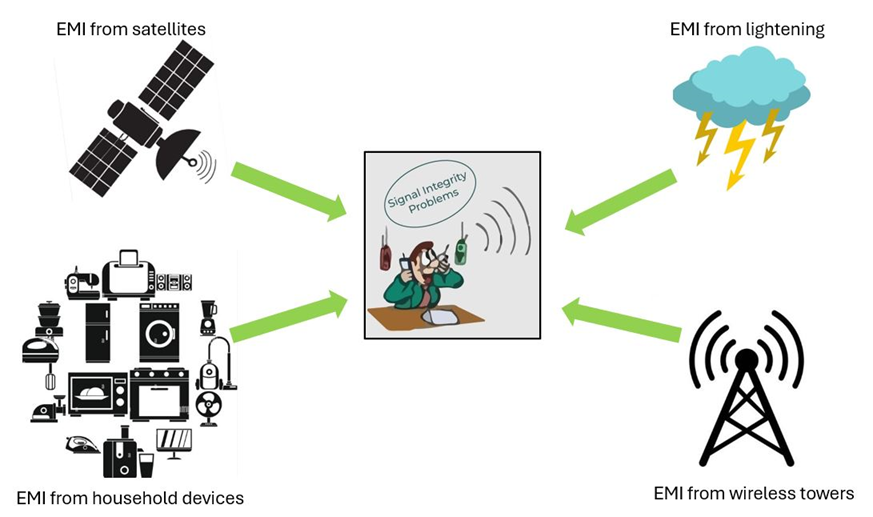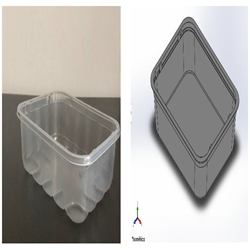In our modern age of technological advancement, electronic devices have become an integral part of our daily lives. From smartphones to medical equipment, these devices serve critical functions. However, they are constantly exposed to electromagnetic interference (EMI), which can disrupt their operations and pose risks to data integrity and user safety.

EMI can originate from various sources, both external and internal. External sources include power lines, radio towers, and even natural phenomena like lightning. These external waves can infiltrate electronic devices, leading to malfunctions and data corruption. Internal sources of EMI arise from components within devices, especially in complex systems where interactions between components generate electromagnetic fields, exacerbating interference issues. The consequences of EMI can be severe, ranging from reduced device performance to compromised safety. In critical systems such as medical devices or aircraft, EMI-induced malfunctions can have life-threatening consequences. Moreover, data corruption due to EMI can lead to erroneous information in vital systems, impacting decision-making processes and potentially endangering lives.
To mitigate the adverse effects of EMI, EMI shielding plays a crucial role. Think of EMI shielding as a suit of armour for electronic devices, protecting them from the onslaught of electromagnetic waves. By employing materials that conduct electricity, such as metals like aluminium, copper, or steel, EMI shielding creates a barrier that deflects or absorbs incoming electromagnetic waves, preventing them from interfering with device operations. EMI shielding operates through various mechanisms, including absorption, reflection, and redirection of electromagnetic waves. Metal enclosures provide a natural barrier against EMI, while conductive coatings and shielding gaskets offer additional protection by sealing out electromagnetic interference. Faraday cages, on the other hand, create a complete enclosure around a device, effectively blocking external electromagnetic fields.
Traditional EMI shielding materials have limitations, particularly in meeting the demands of modern electronic devices and dynamic operating environments. Researchers have been exploring smart EMI shielding materials that can dynamically adjust their shielding effectiveness in response to environmental changes. These materials incorporate conductive or magnetic elements with stimuli-responsive properties, allowing them to adapt their shielding capabilities in real-time.
The significance of EMI shielding extends across various sectors, including consumer electronics, healthcare, automotive, aerospace, telecommunications, and military applications. In consumer electronics, EMI shielding ensures the reliable performance of devices like smartphones, laptops, and televisions. In critical applications such as medical devices and aerospace electronics, EMI shielding is essential for maintaining operational integrity and safety.
While conventional EMI shielding materials have been effective, there's a growing emphasis on sustainability in material design. Biocomposites offer a promising alternative, combining effective shielding properties with biodegradability, reducing environmental impact and addressing concerns about e-waste generation. Nanomaterials have ushered in a new era of innovation in EMI shielding, leveraging their distinctive attributes like high surface area, tunable conductivity, and lightweight nature to surpass conventional materials in performance. Graphene, with its singular structure of carbon atoms forming a robust lattice, boasts remarkable electrical conductivity and strength, leading to the derivation of Graphene Nanoplates (GNPs), integrated into polymer composites to bolster EMI shielding capabilities. Similarly, Carbon Nanotubes (CNTs), comprised of rolled-up graphene sheets, create conductive networks within polymers, heightening their ability to dissipate electromagnetic energy and enhance EMI shielding effectiveness, particularly favoured for lightweight and flexible solutions. One-dimensional structures like Silver Nanowires (AgNWs) demonstrate high electrical conductivity and easy dispersion within polymers, making them appealing for EMI shielding coatings or films that offer superior protection against electromagnetic radiation. Transitioning to Two-Dimensional (2D) Materials such as transition metal dichalcogenides (TMDs) and MXenes, their unique electronic and optical properties enrich composite structures, augmenting conductivity and absorption of electromagnetic waves, while their ultrathin profile enables the creation of thin and flexible EMI shielding coatings. Furthermore, the integration of Metallic Nanoparticles, including copper, aluminium, or nickel, into polymer matrices further enhances EMI shielding performance by promoting conductivity and effectively scattering and absorbing electromagnetic waves, rendering metallic nanoparticle-based composites highly advantageous for applications requiring transparency or flexibility.
As we continue to rely on electronic devices for communication, work, and leisure, the importance of EMI shielding cannot be overstated. It serves as a crucial defence against the invisible threats posed by electromagnetic interference, ensuring the reliability, safety, and integrity of our electronic systems. Through continued research and innovation, we can further enhance EMI shielding technology, safeguarding our electronic world for generations to come.
Dr. Ismayadi Ismail
Research Officer
Nanomaterials Synthesis and Characterisation Laboratory (NSCL)
Institute of Nanoscience and Nanotechnology, UPM
Date of Input: 29/03/2024 | Updated: 29/03/2024 | nurnazeera
MEDIA SHARING
























